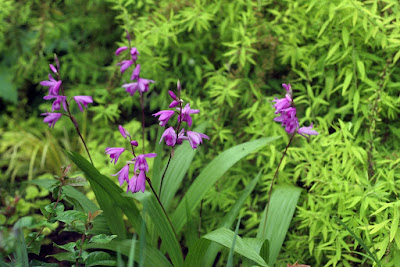Bletilla striata is native to Japan, Korea, Myanmar (Burma), and China (Anhui, Fujian, Gansu, Guangdong, Guangxi, Guizhou, Hubei, Hunan, Jiangsu, Jiangxi, Shaanxi, Sichuan, Zhejiang). It grows in evergreen broad leaved forests, coniferous forests, grassy places and crevices at elevations of 100 to 3200 meters.
Bletilla striata also called as The Striped Bletilla, Hyacinth Orchid, Chinese Ground Orchid, Bletilla elegantula, Bletia gebina, Bletia hyacinthina, Bletia hyacinthina var. gebina, Bletia striata, Bletilla gebina, Bletilla hyacintha, Bletilla striata f. gebina, Bletilla striata var. albomarginata, Bletilla striata var. gebina, Calanthe gebina, Coelogyne elegantula, Cymbidium hyacinthinum, Cymbidium hyacinthinum, Cymbidium hyacinthinum, Cymbidium striatum, Epidendrum striatum, Epidendrum tuberosum, Gyas humilis, Jimensia striatum, Limodorum hyacinthinum, Limodorum striatum, Polytoma inodora, Sobralia bletioides, is a species of the genus Bletilla. This species was described by Heinrich Gustav Reichenbach in 1878.
IDENTIFY BLETILLA STRIATA ORCHID PLANT
Bletilla striata is native to Japan, Korea, Myanmar (Burma), and China (Anhui, Fujian, Gansu, Guangdong, Guangxi, Guizhou, Hubei, Hunan, Jiangsu, Jiangxi, Shaanxi, Sichuan, Zhejiang). It grows in evergreen broad leaved forests, coniferous forests, grassy places and crevices at elevations of 100 to 3200 meters.
The Striped Bletilla is a small to medium sized, cool to cold growing terrestrial with subterranean rounded and compressed pseudobulbs with an erect, 30-70 cm tall stem that bears 4 to 5, oblong-lanceolate, plicate, acuminate apically, flexible, 20-30 cm long, 2-5 cm wide leaves.
Chinese Ground Orchid blooms on a lax, terminal, 60 cm long inflorescence arising with a new pseudobulb that has 3 to 12, fragrant, somewhat nodding flowers that open in succession in the spring. The flowers are 2.5 to 5.5 cm in diameter, rose-purple, sepals and petals alike.
BLETILLA STRIATA ORCHID PLANT CARE AND CULTURE
Cultural information should only be used as a guide, and should be to be adapted to suit you. Your physical location; where you grow your plants, how much time you have to devote to their care, and many other factors, will need to be taken into account. Only then can you decide on the cultural methods that best suit you and your plants.
Light:
Bletilla striata need to receive sunlight for most of the day if they are to flower well and do best in semi shade avoiding the hot afternoon sun.
Temperature:
The Striped Bletilla will tolerate the typical temperatures from -2 to 44°C providing they are given protection from frosts in winter. Ideally they should be grown in a shade-house or protected verandah position where they are protected from frosts and direct summer sun.
Humidity:
Maintaining high humidity is not as important with Chinese Ground Orchid as other orchid species and misting sprays are generally not required except on extremely hot days with temperatures greater than 42°C.
Substrate, growing media and repotting:
Bletilla striata need a well draining humus rich potting mix containing loam and leaf mulch and some fertilizer should be used that should last for 3 to 4 years to avoid the need for repotting. A normal shape 250mm diameter nursery pot is best. The bulbs should be placed about 5 to 10 cm below the surface of the potting mix. Avoid breaking roots when repotting.
Hyacinth Orchid should be repotted in early autumn soon after the leaves have died back at the end of May. Do not delay repotting as the pseudobulbs shoot below the surface in early winter and the new shoots are easily broken during repotting. They do not like being disturbed and may not flower well for the first year after repotting. They should only be repotted after they have filled the pot or the potting mix needs replacing.
Watering:
Chinese Ground Orchid require regular watering during the growing period. Once the leaves have died down in autumn they should not be watered for the next 4-6 weeks and allowed to rest dry to avoid rotting the bulbs.
Fertilizer:
The plants require frequent fertilizing every 2 to 3 weeks during their active growing period. A high N fertilizer is recommended in spring and early summer but switch to a high phosphorus and potassium fertilizer in late summer and early autumn. Stop fertilizing in late autumn.
Rest period:
Bletilla striata needs a clearly rest period in winter with lower temperature. Stop fertilization in late autumn and reduce watering. When the new leaves have appeared in late winter watering can be resumed but only sparingly for the first few weeks as roots do not develop until about 4 weeks after the shoots appear.

















Gracias por todos los artículos sobre orquídeas. Muchas gracias!
DeleteWelcome!
DeleteI am on my third set of bulbs that won't break dormancy. I have put them in the ground, in a pot, but no success. What am I doing wrong?
DeleteCold treatment is the best way for breaking the internal dormancy. The minimum duration of cold treatment in order to break the internal dormancy could be 90 days with a temperature of about 4 ℃.
DeleteThanks. I will have to try that.
Delete